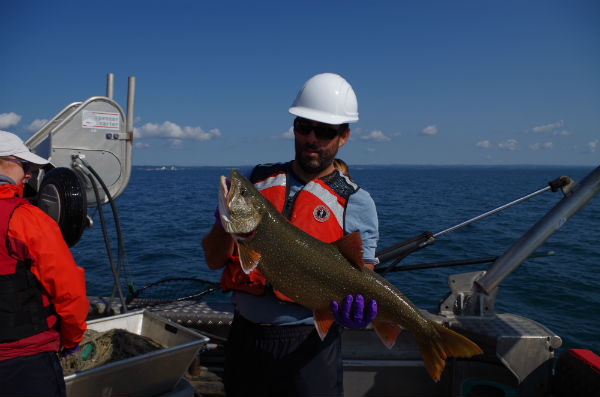While you may not have heard of hexabromocyclododecane (HBCDD), you’ve more than likely come into contact with it. Since the 1960’s, it’s been found in products we use every day – from electronics to plastics. It is primarily used in polystyrene foam used for building insulation.
While HBCDD acts as a flame retardant, it also comes with environmental concerns. It takes a long time to break down and it tends to be absorbed at a higher concentration as it moves up the food chain. This makes HBCDD particularly concerning, especially when it comes to top-predator freshwater fish. HBCDD is also susceptible to long-range transport. It can travel in gas form or attached to dust particles, far from where it is produced, even making its way up to the Arctic.
Scientists based at the Canada Centre for Inland Waters (CCIW) in Burlington, Ont. took a closer look at HBCDD in waterways across Canada. An article by a team from the Centre, “Isomer-Specific Hexabromocyclododecane (HBCDD) Levels in Top Predator Fish from Across Canada and 36-Year Temporal Trends in Lake Ontario,” was published earlier this year in Environmental Science & Technology.
Daryl McGoldrick, based at the CCIW and one of the paper’s authors, noted that their goals were twofold. The first was to determine the current amount and type of HBCDD in lake trout, walleye, and brook trout across Canada. The second goal was to look at historical HBCDD trends from 1979-2015 in lake trout found in Lake Ontario.
Fish collected from lake, rivers, and reservoirs all across Canada were frozen and brought to the CCIW. Fish then underwent in-depth analysis for HBCDD.

ECCC scientists determine the amount of HBCDD in freshwater fish across Canada.
The research found that the pollutant was present in about 90% of the fish samples they analyzed. While there were traces of the pollutant at all 20 sites surveyed across Canada, the highest levels were in the Great Lakes sampling sites, especially Lake Ontario. High levels were also present in Lac Memphrémagog, Quebec, an area that historically manufactured products containing HBCDD.
The authors delved deeper into the Lake Ontario trout samples, since this area had the high levels of HBCDD and a long time series of samples preserved in ECCC’s National Aquatic Biological Specimen Bank. The trend from 1979 to 2015 showed “no significant decrease or increase,” in HBCDD. However, the specific type of HBCDD found in the lake changed dramatically. Two types of HBCDD, chemists call them isomers, are typically present in environmental samples. Gamma-HBCDD is more abundant in the technical mixture used directly in products and alpha-HBCDD is more abundant in fish tissues. The researchers found that despite there being no change in the levels of all types of HBCDD combined – the amount of ‘gamma HBCDD’ isomer in fish from Lake Ontario has decreased over time. This is interesting as it may indicate a reduction in the amount of “new” HBCDD entering the environment from our products.
While the levels found in fish are below levels deemed harmful to human health, there is still work to be done to ensure HBCDD levels are reduced.
In fact, over the past few years, Canada has been a world leader on ensuring we see less of this harmful substance. In 2012, HBCDD was added to the list of toxic substances in the Canadian Environmental Protection Act and a Chemical of Mutual Concern in the Great Lakes Water Quality Agreement. In 2013, Canada and Norway led the charge to have HBCDD listed in the Stockholm Convention of Persistent Organic Pollutants.
While it is too early to determine the impact of these measures on HBCDD levels, the scientists hope to be able to use the 2013 and 2015 results as baseline. Nevertheless, our McGoldrick says it is a positive sign that HBCDD has not been increasing.
“It will take time to work their way out the environment,” he says. This is largely due to HBCDD’s quality of being difficult to break down. However, the team at CCIW hopes to monitor sites across the country each year, to eventually confirm that concentrations are decreasing over time.
“These results will contribute to a baseline with which to compare future measurements of HBCDD in fish to evaluate the effectiveness of risk management actions taken to reduce the levels of the HBCDD in the Canadian environment” (p. 6205).
